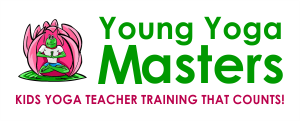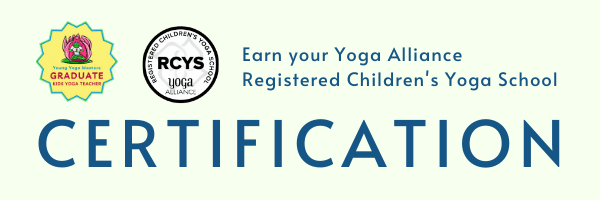If you are considering taking a kids yoga teacher, the one you choose is an important decision for the short term and the long term.
We’ve been a Registered Children’s Yoga School since 2012. And we have seen a lot of schools come and go in that time. We’ve stayed up to date on the most current Yoga Alliance standards and navigated our way through the pandemic.
In this article we share this experience to help you choose the best training FOR YOU, even if it is not our training, so that you can become a confident and qualified children’s yoga teacher.
This is a long one, so grab a cup of tea and enjoy the read, then make an informed decision for the kids yoga teacher training you choose.
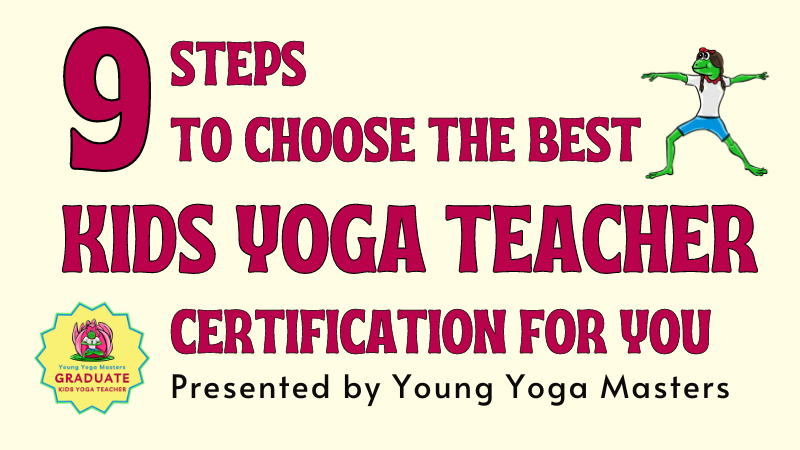
Here are 9 Steps to help you determine the best kids yoga teacher training (updated Feb. 1, 2024)
Step #1: Educate Yourself on the Different Levels of Certification for Children’s Yoga Teachers
A lot of people who want to teach yoga don’t know what training they need and are surprised to find out that yoga is an unregulated industry!
This means you can teach yoga to children or adults without a certificate.
Why do you need a Yoga Teaching Certificate?
For a few reasons:
- Skill Development: Because they don’t know how to teach yoga to their niche (children, adults, prenatal etc).
- Professionalism: They want recognition to put on their resume, in the form of a Certificate, that confirms their knowledge and training so they can get jobs.
- Insurance: They need insurance for their business and need a Certificate to get it.
- Community Recognition: People within the yoga community know about all the different levels of certification, plus to register with organizations like Yoga Alliance, you may want the recognition the certificate provides.
- Life-long learners: enjoy taking courses to learn new activities and connect with other teachers and trainers, so they earn the Certificate and get to keep learning too.
While legally speaking you don’t need a Certificate to teach yoga, if you decide to get one, choose a training that will open doors for you.
This is where the different levels of Certification come in.
For teaching adult yoga, the most recognized standard is completing a 200 hour training, there are many more options for kids yoga teachers.
Levels of Certification in Children’s Yoga
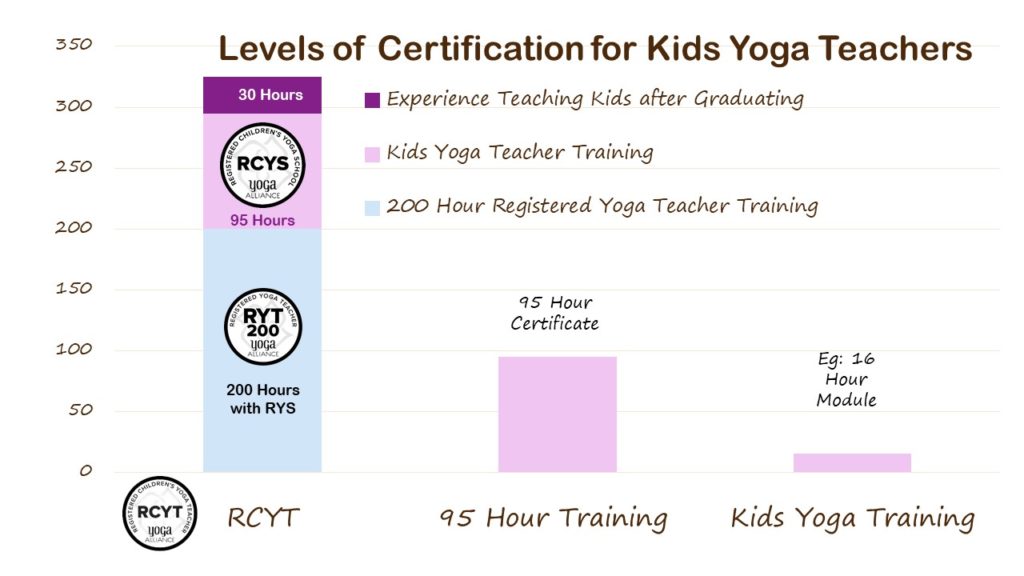
Basic Kids Yoga Training
The very basic level is getting a certificate for a short training. Shorter training certificates are often between 8 – 20 hours.
The 95 Hour Training:
Often those who want to teach yoga to children, and not adults, aim for the 95 Hour Certification. 95 Hours is the number of hours Yoga Alliance (YA) established for a training in the specialty of children’s yoga. Usually this number of hours is with a YA Registered Children’s Yoga School (RCYS), but not always.
Check if the course/school is actually listed on the YA website by checking their name in the Yoga Alliance directory.
You Can’t Combine Training Certificates
Also note that for YA the 95 Hours of training must come from one school’s Certification program. You can’t combine or add up Certificates from different schools till you get to 95 Hours. This is because an RCYS makes sure you’ve covered all the different curriculum requirements, like practicum and anatomy, and if you are combining certificates, they won’t know that you’ve learned all the core competencies required by YA.
RCYT: Highest YA Credential for Children’s Yoga Teachers
According to the Yoga Alliance standards, the RCYT designation (RCYT stands for registered children’s yoga teacher) is the gold star!
To get the RCYT designation you’ve completed:
- 95 hour certificate
- plus a 200 hour yoga teacher training
- both trainings are with YA registered yoga schools,
- and then you need 30 hours of experience teaching kids yoga classes AFTER you graduate from the training (this credential means you have experience too).
All of these requirements are part of the self-regulated yoga credentialing system established at YA. You don’t need to have these credentials to teach, many teachers teach without them. However, this is the industry recognized “gold star” on your resume that you’re investing in through the training you choose.
Your Yoga Certification may affect Your Long Term Goals
While many kid’s yoga teachers teach classes will the various levels of certification, some doors will close for you if you don’t have the RCYT designation. Many people have completed our training simply because their initial training was not registered with Yoga Alliance and they couldn’t get the RCYT designation. Why did they want the RCYT credential so badly? They were invited to be a trainer in a RCYS (School) and YA only allows those with a RCYT credential to be a trainer in a RCYS.
If you see teaching kids yoga as a long term endeavor, one day you will probably think about being a trainer. While you don’t have to offer your training through YA, having a Yoga Alliance RCYS training brings in more students for most schools.
You can find out more details about the impacts of the level of Certification you choose here.
Do You Have other Qualifications
Some people have other diplomas or certificates that will complement their children’s yoga training. For instance, they may be an early childhood educator, a school teacher, a therapist, or a dietitian who works with children.
If you have other Certificates you’ll be more qualified as teaching children’s yoga and mindfulness. We’ve found those with other diplomas or certificates, understand the value of the full 95 Hour Certification and set their sights on earning the highest level credential as a children’s yoga teacher as well.
Certification Recommendation:
We recommend that if you are starting out, choose a training that will allows you to register with Yoga Alliance if you choose. This will give you more long term opportunities. If you don’t choose a Yoga Alliance registered training, get clear on the reason you are closing that door now so you can reflect back on it in the future.
Step #2: Consider How You Learn Best
Looking back on yoga teacher training requirements you can see how they’ve changed significantly:
- Before 2020: Yoga Alliance allowed only in-person yoga training, meaning all training had to be in the physical presence of your trainer. A maximum of 8 hours of homework was permitted in the 95 Hour Training.
- COVID Training Provisions (2020 – 2023): “Asynchronous” and distance learning was permitted. A minimum of 1 hour of the 95 hour training had to be “Synchronous” or in real-time and could be online (e.g. Zoom) or in-person.
- 2024 Onward: Children’s yoga training may be offered 100% In-Person learning, 100% distance learning, or a blend of these. For schools offering distance learning, a minimum of 14 hours of the 95 Hour Training must be in real-time/synchronous (teachers and students gather online at the same to interact in real-time). For a 200 Hour Adult training, a minimum of 30 hours must be in real-time.
You have more choices than ever to learn in 2024 onward.
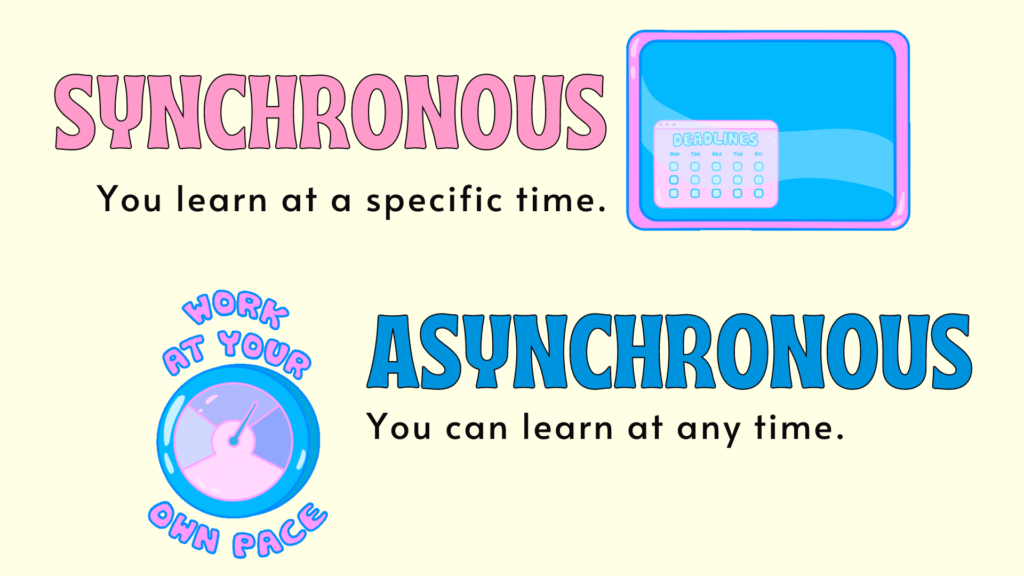
Synchronous learning requires real time interaction. Examples are in- person or live training on Zoom, where you are required to show up at certain times for the training. People don’t have to be in the same room, but everyone is together at the same time. That’s synchronous.
Asynchronous learning is also permitted by Yoga Alliance. With Asynchronous learning, you can learn on your own time. It’s also known as self-paced learning. You might watch recordings of a training or do assignments. This training happens at the time you choose.
The question is: How do you learn best?
Since there are so many options you want to choose a training that you will get the most from and actually complete.
Are you good at completing training on your own time? One way to get a true gauge of your aptitude for synchronous or asynchronous learning is by looking at your training history.
When you look back on other courses you’ve taken, which ones did you successfully complete? Were they synchronous or asynchronous?
Have you signed up for a live training event and not been able to make the dates?
Did you singed up for self-paced training and didn’t complete it?
On a side note: These questions are offered for you to explore with curiosity, not judgement. Everyone learns differently, it is good to know yourself this way. For example, I don’t allow myself to sign up for self-paced courses anymore until I complete the ones I’ve already got. I’ve noticed that I’m more successful completing synchronous courses, but that’s just me.
Other people have signed up for our self paced training and completed it within a month.
Be curious with yourself and your learning style and what training styles light you up.
Recommendation: Your past experience can serve as a starting point to make training choices for yourself. What fun and enjoyable format will make it easiest for you to follow through, so you actually graduate from the training you choose?
Step #3: Weigh the Pros and Cons for the Real-Time Training Requirements
When it come to real-time yoga teacher training requirements, you may thrive on interacting with others in a studio or you may like the ease of stepping up to your computer and turning it on. Either way, a minimum of 14 hours of real-time training are now required for the 95 Hour Certificate.
Next step is to weigh your options for:
- How Much Real-Time Training? Do you want the minimum 14 hours real-time training or more?
- In-Person Training: do you want to go into a studio for in-person training?
- Real-Time on Zoom: do you want to login from your home (e.g. on Zoom) for the real-time training?
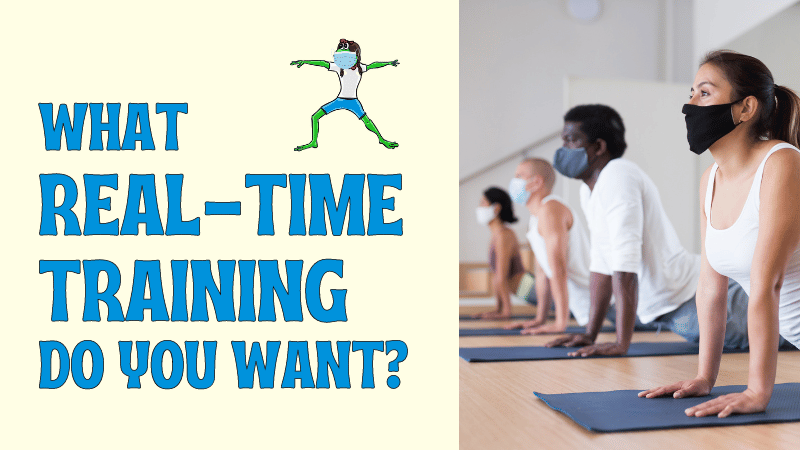
Challenges for In Person Training
Even though you may miss it, you may not feel comfortable going into a studio and training in person. If you are considering in person training, assess your comfort level around:
- Mask or no mask and studio ventilation?
- Class size?
- Where is it offered? Is it local or do you have to travel for an In-Person training? Will you travel to a sunny spot or in snow or rainy conditions?
- Duration of the class – how long will you be at the training each visit?
- Will the in-person training be recorded for you to review later?
- Cost of in-person training compared to online?
Real-time on Zoom/Online
On the other hand, real-time training from home on zoom has other factors. You’ll get interaction with other participants but not in the same way as you would if you were in a live training.
For real-time online training find out:
- Duration of each session – how long will you be looking at the screen for each session?
- Class size?
- Will you be required to turn on your camera?
- Will there be break out rooms for you to meet other students?
- Will it be recorded for you to watch later?
- Will your home life allow you to take the training uninterrupted?
- Cost of online training compared to in-person?
Recommendation: Consider your real-time training options and how much training you want in real-time for you to learn best. Consider all your options for the minimum 14 hours (or more) of real-time training.
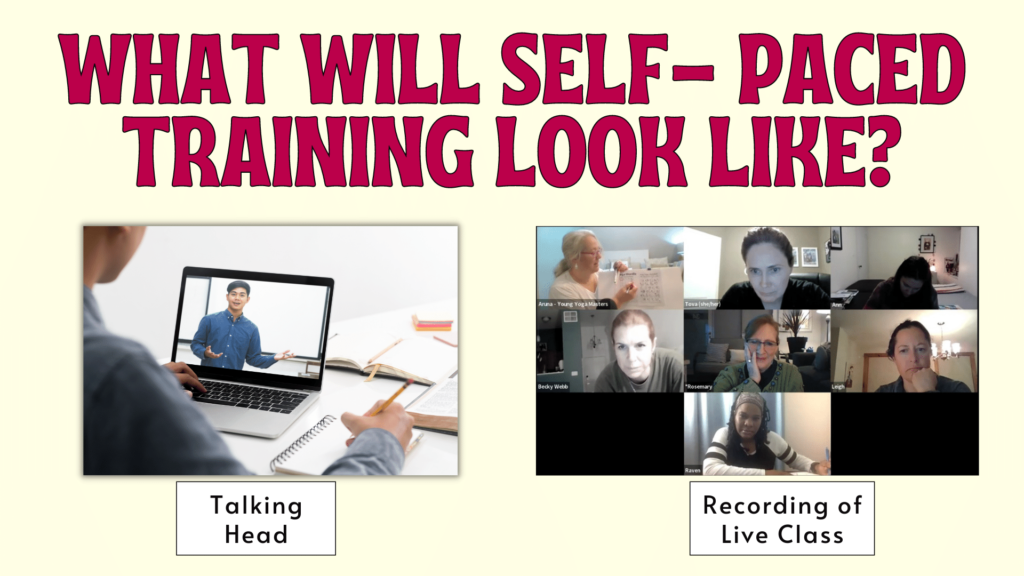
Step #4: Weigh the Pros and Cons of the Self-Paced Training
Since the Yoga Alliance has allowed distance learning to continue, most trainings include some element of self paced training. Some self-paced training consists of the trainer looking into a camera teaching about being a kids yoga teacher. It is usually direct and to the point, depending on the trainer.
Other self-paced recordings are of a cohort taking the training. You’re hearing your trainer and also listening to the discussion and questions from students, which feels more like a live training.
When a trainer is talking into a camera camera, the information is usually direct and you won’t have the same tangents that happen in a live training.
However, the tangents can be interesting things that inspire you. You get to hear other people’s ideas and suggestions.
And you just may find it easier to listen to a group talking versus listening to one person talking into a camera.
Recommendation: If you want a self paced training, find out what kind of videos you’ll be watching.
When comparing different trainings, watch the sample videos that are provided. You’ll see if you like the style. If you can’t get through the sample video, just think how hard it will be to get through 95 hours of this type of video!
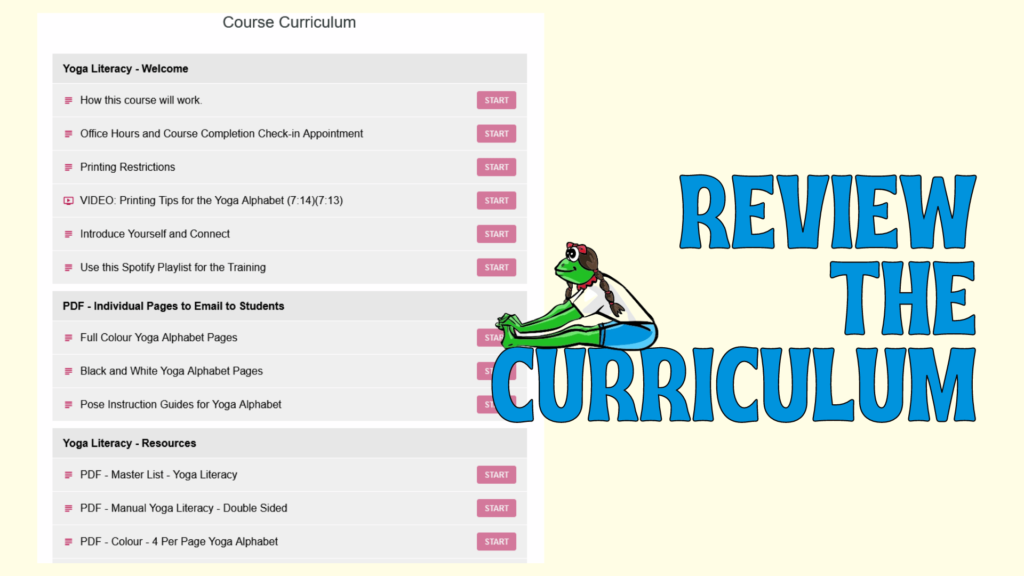
Step #5: Review the Training Curriculum
Each training has its own personality in how it organizes all the topics that are covered in a Kid’s Yoga and Mindfulness Teacher Training.
Go onto the website where the training is offered and review the curriculum of the training to see if this is what you want to learn.
Does the training cover all the topics you want to learn?
Does it cover special needs?
Does it offer trauma informed principles?
Does it cover the age group that you want to teach?
Recommendations: Find where the course is hosted and review the training curriculum in each course. You’ll get an understanding of the training curriculum to choose the best training for you.
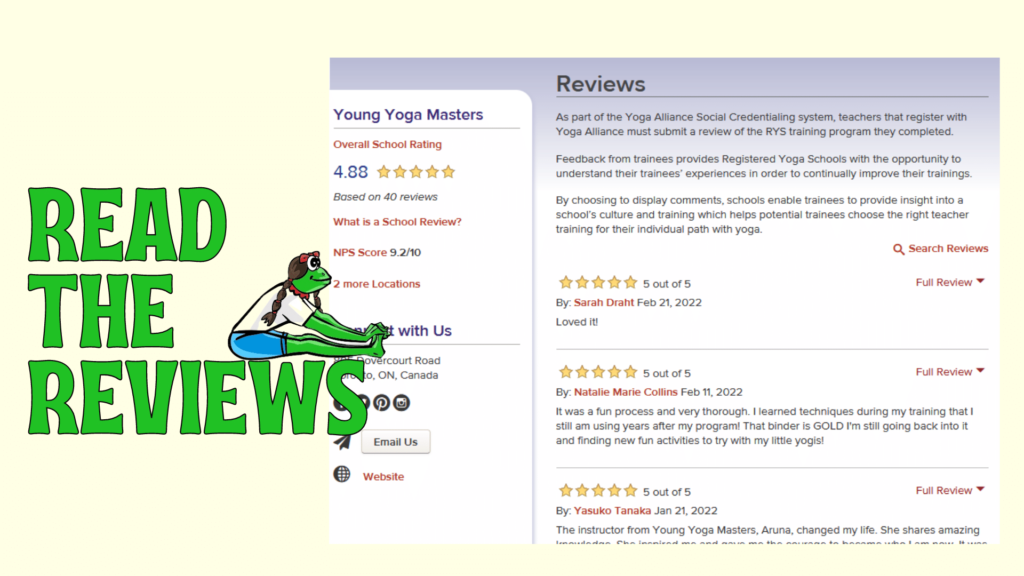
Step #6: Read the Reviews
The testimonials on a website for a training are curated to only include the best reviews.
Recommendation: Read the third party reviews on Yoga Alliance or Google.
The third party reviews will give you a more honest picture of the training. We all know most people read the most negative reviews first, so check it out and get a feeling for what any of the issues were. Even if a school has a lower review, the comment will tell you if the problem would be an issue for you.
If there are many low ratings, buyer beware!
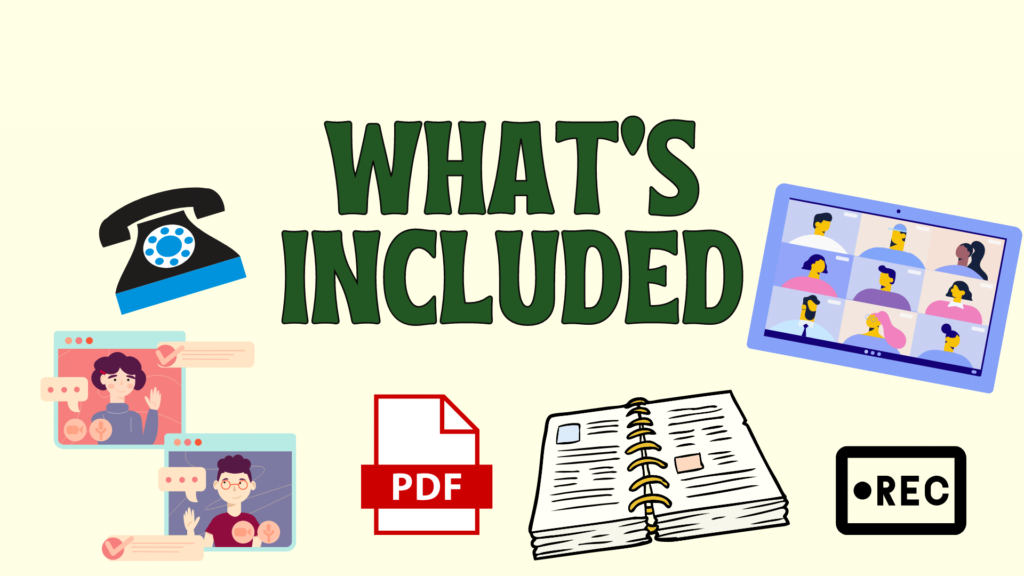
Step #7: Know what is Included in the Training
Each Training offers different extras. Some include printed manuals, but no PDFs. Some include PDFs but no printed manuals.
Check the refund policy and transfer policy.
How is the course organized for you to access the instructions, printable resources, and replays (if any).
You also want to know what kind of support you get during and after the training. How often do you have direct access to the trainers to ask questions that come up? Does the training offer support after you graduate?
Can you connect with other participants in the training? What kind of groups do you become part of during and after the training?
And finally, be sure you know exactly what courses you are getting.
For instance, if you sign up for a 95 hour training, does it include all the modules. I’ve seen schools charge extra for mentoring and practicum, extra courses, or for your final certificate. Make sure you understand the full training requirements before you buy.
Recommendation: If you aren’t sure what you are getting with the training, email and ask the school. That way you will have a document of exactly what you can expect. You’ll also get a feel for how quickly people get back to you!
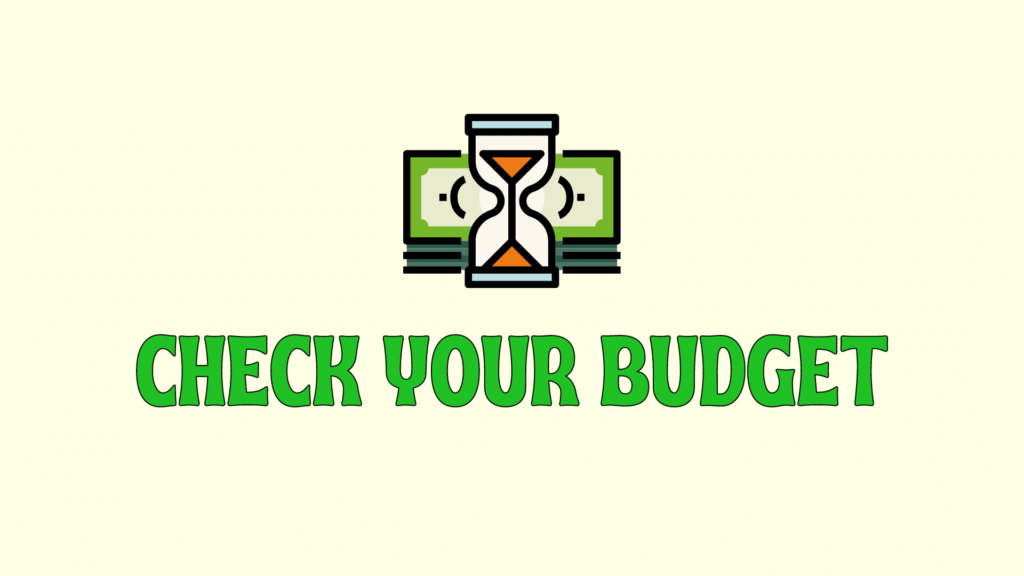
Step #8: Look at Your Budget
Once you’ve got a list of all the things you want in a training then check the price of that training.
Can you afford it?
Do they offer payment plans?
Do they offer scholarships?
Recommendation: You are going to invest your energy, time, and money into this training so take one you are excited about, but make sure it works with your budget.
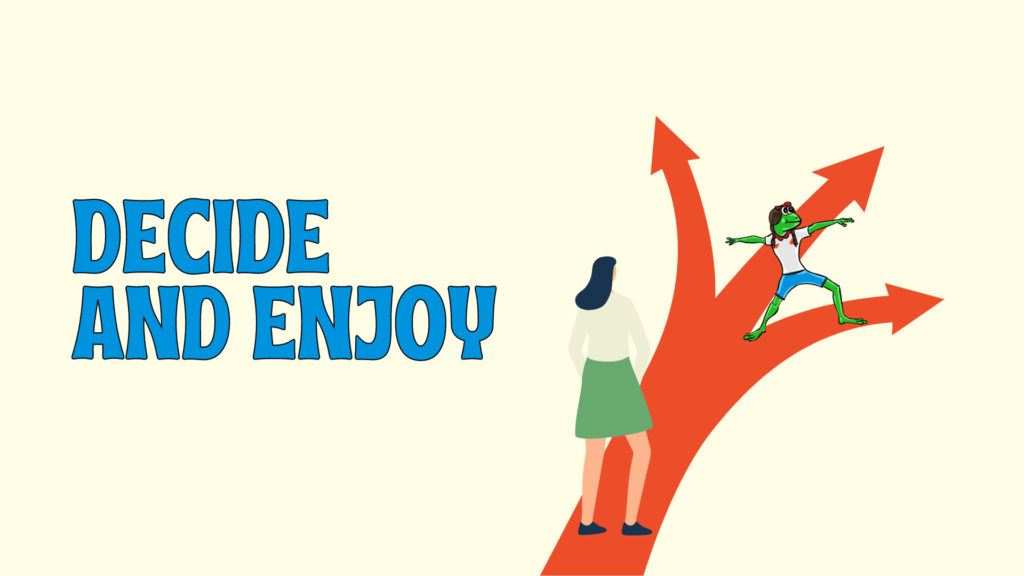
Step #9: Make Your Decision and Enjoy
Recommendation: Once you move through the above steps, trust your instincts and make a decision. Then start the training.
Give yourself a pat on the back for making the best decision you could with the information you had and avoid second guessing yourself.
Immerse yourself in the training, learn everything you can from it. Use all the resources offered.
Teacher training is such a special time, you may be sad when it is over! Enjoy it while it happens.
And most importantly, start teaching what you learn to children as soon as possible. This will really help you integrate the training and help it stick.
The next thing you know, you will be a more confident and skilled children’s yoga and mindfulness teacher.
If you have any questions about choosing the right training for you, or the Yoga Alliance training requirements, you can contact us and we will happy to help you figure out what’s best for your situation.
